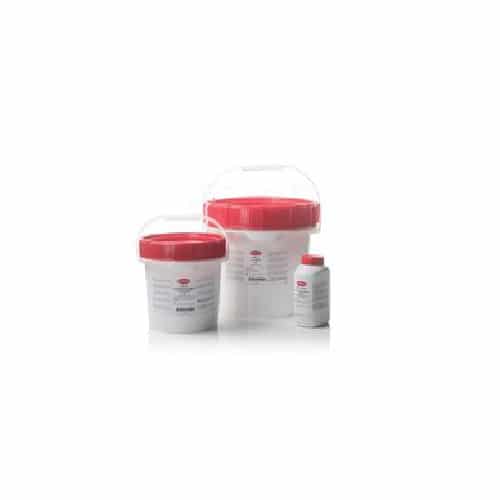
DNase agar 500g
RM974.00Brand:
Thermo ScientificTM OxoidTM
Detect microbial deoxyribonuclease enzymes, particularly from staphylococci, with Thermo Scientific™ Oxoid™ DNASE Agar (Dehydrated). A DNase (deoxyribonuclease) is any enzyme that catalyzes the cleavage of phosphodiester linkages of DNA leading to its degradation. The organisms producing DNase enzymes in sufficient quantities to hydrolyze DNA will show clear zones around the colonies. The medium is mainly used in the identification of staphylococci but may also be used for the detection of DNase activity in other organisms.
DNASE Agar, Oxoid Composition
| Typical Formula* | gm/litre |
| Tryptose | 20.0 |
| Deoxyribonucleic acid | 2.0 |
| Sodium chloride | 5.0 |
| Agar | 12.0 |
| pH 7.3 + 0.2 |
DNASE Agar, Oxoid Preparation:
Suspend 39g in 1 litre of distilled water and bring to the boil to dissolve completely. Sterilise by autoclaving at 121°C for 15 minutes.
Storage conditions and Shelf life
Store the dehydrated medium at 10-30°C and use before the expiry date on the label.
Store the prepared plates of medium at 2-8°C.
Precautions
The DNase reaction for staphylococci is an indication of pathogenicity, it cannot be used as the sole criterion for identification.
Small zones of clearing may be caused by other enzymes or organic acid production.
Other organisms than staphylococci, Serratia and aeromonads can produce DNases.
Once the hydrochloric acid has been applied to the medium the plate must be read within a few minutes and further testing cannot be carried out by re-incubation.
The methyl green must be purified by extraction with chloroform.
Toluidine blue varies in performance according to source.
Merck Toluidine blue 1273 is satisfactory. Note that this dye cannot be used for Gram positive organisms.

Do30 Doxycycline
RM77.00Brand:
Thermo ScientificTM OxoidTM

Dor10 Doripenem 10µg
RM0.00Brand:
Thermo ScientificTM OxoidTM
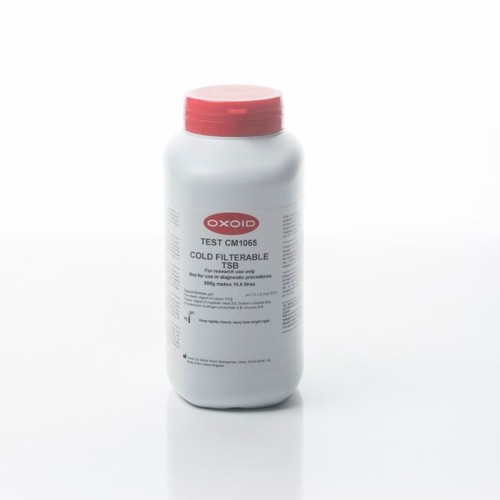
DRBC (ISO) Agar Base 500g
RM392.00Brand:
Thermo ScientificTM OxoidTM
Isolate and enumerate yeasts and molds associated with food spoilage with Thermo Scientific™ Oxoid™ Dichloran Rose-Bengal Chloramphenicol (DRBC) (ISO) Agar Base while adhering to ISO 21527-1: 2008. Dichloran Rose-Bengal Chloramphenicol (DRBC) (ISO) Agar is specially designed to suppress the growth of spreading mold and bacteria while supporting the growth of species that cannot be isolated on Rose Bengal Chloramphenicol Agar or Acidified Potato Dextrose Agar.
Dichloran Rose-Bengal Chloramphenicol (DRBC) (ISO) Agar, Oxoid Composition
| Typical Formula* | gm/litre |
| Peptone | 5.0 |
| Glucose | 10.0 |
| Potassium dihydrogen phosphate | 1.0 |
| Magnesium sulphate | 0.5 |
| Dichloran | 0.002 |
| Rose-bengal | 0.025 |
| Agar | 15.0 |
| pH 5.6 ± 0.2 @ 25°C |
Dichloran Rose-Bengal Chloramphenicol (DRBC) (ISO) Agar, Oxoid Preparation:
Suspend 15.75g per 500ml (31.5g/l) of distilled water and heat to dissolve completely. Reconstitute Chloramphenicol Supplement (one vial SR0078E per 500ml or one vial SR0078H per 2 litres medium), as directed. Add the vial contents to the DRBC (ISO) Agar Base. Sterilize by autoclaving at 121°C for 15 minutes. Cool to 50°C, mix well and pour into sterile Petri dishes.
Storage conditions and Shelf life
Store the dehydrated medium at 10–30°C and use before the expiry date.
Precautions
ROSE-BENGAL PHOTO-OXIDIZES TO FORM TOXIC COMPOUNDS. STORE PLATES OF THE MEDIUM IN THE DARK AND AVOID EXPOSURE TO LIGHT.
Some strains of fungi may be inhibited on this medium.
The dichloran compound used in this medium is Botran® 2,6-Dichloro-4-Nitro-Analine (CAS: 99-30-9).
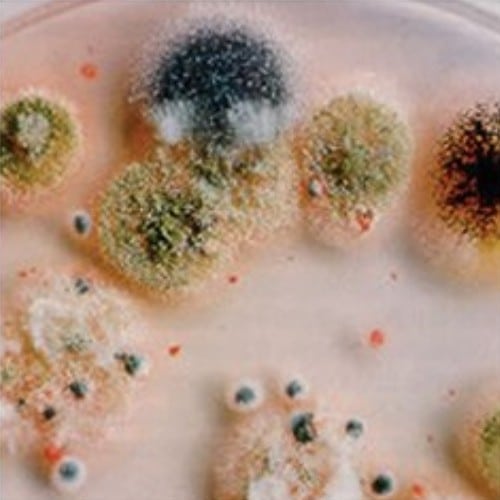
DRBC Agar Base 500g
RM546.00Brand:
Thermo ScientificTM OxoidTM
- Oxoid DRBC Agar Base (Dichloran Rose-Bengal Chloramphenicol Agar Base) is a selective medium for yeast and molds associated with food spoilage.
- Also available Chloramphenicol Selective Supplement, Part No. SR0078E and Chloramphenicol Selective Supplement, Part No. SR0078H
DRBC Agar Base, Oxoid Composition
| Typical Formula* | gm/litre |
| Peptone | 5.0 |
| Glucose | 10.0 |
| Potassium dihydrogen phosphate | 1.0 |
| Magnesium sulphate | 0.5 |
| Dichloran | 0.002 |
| Rose-Bengal | 0.025 |
| Agar | 15.0 |
| pH 5.6 ± 0.2 @ 25°C |
DRBC Agar, Oxoid Preparation:
Suspend 15.75g in 500ml (31.5g/l) of distilled water and heat to dissolve completely. Reconstitute one vial SR0078E per 500ml medium or one vial SR0078H per 2 litres medium, as directed. Add the vial contents to the DRBC Agar Base. Sterilise by autoclaving at 121°C for 15 minutes. Cool to 50°C, mix well and pour into sterile Petri dishes.
Storage conditions and Shelf life
Store the dehydrated medium at 10-30°C and use before the expiry date on the label.
Store the prepared plates of medium at 2-8°C.
Precautions
ROSE-BENGAL PHOTO-OXIDIZES TO FORM TOXIC COMPOUNDS. STORE PLATES OF THE MEDIUM IN THE DARK AND AVOID EXPOSURE TO LIGHT.
Some strains of fungi may be inhibited on this medium.
The dichloran compound used in this medium is Botran® 2,6-Dichloro-4-Nitro-Analine (CAS: 99-30-9).

E.C. Broth 500g
RM474.00Brand:
Thermo ScientificTM OxoidTM
Selectively detect Escherichia coli from food and environmental samples with Thermo Scientific™ Oxoid™ EC Broth (Dehydrated). EC Broth is a selective medium for the differentiation of fecal coliforms and the confirmatory test for Escherichia coli from food and environmental samples. It is also suitable for the enumeration of presumptive E. coli in milk and milk products using the most probable number technique.
EC Broth, Oxoid Composition
| Typical Formula* | gm/litre |
| Tryptone | 20 |
| Lactose | 5.0 |
| Bile salts No. 3 | 1.5 |
| Di-potassium phosphate | 4.0 |
| Mono-potassium phosphate | 1.5 |
| Sodium chloride | 5.0 |
| pH 6.9 ± 0.2 @ 25°C |
EC Broth, Oxoid Preparation:
Dissolve 37g in 1 litre of distilled water. Dispense into final containers and sterilize by autoclaving at 121°C for 15 minutes.
Storage conditions and Shelf life
Store the dehydrated medium at 10-30°C and use before the expiry date on the label.
Store the prepared medium at 2-8°C for up to 4 weeks.

E.C. Broth with Mug 500g
RM808.00Brand:
Thermo ScientificTM OxoidTM
Oxoid EC Broth with MUG is used for the isolation and presumptive identification of E. coli.
EC Broth with MUG, Oxoid Composition
| Typical Formula* | gm/litre |
| Tryptone | 20.0 |
| Lactose | 5.0 |
| Bile salts No. 3 | 1.5 |
| Di-potassium phosphate | 4.0 |
| Mono-potassium phosphate | 1.5 |
| Sodium chloride | 5.0 |
| 4-methylumbelliferyl-ß-D-glucuronide (MUG) | 0.05 |
| pH 6.9 ± 0.2 @ 25°C |
EC Broth with MUG, Oxoid Preparation:
Suspend 37g of EC Broth with MUG in 1 litre of distilled water. Mix well to dissolve and distribute into final containers containing inverted Durham tubes. Sterilise by autoclaving at 121° C for 15 minutes.
Storage conditions and Shelf life
Store the dehydrated medium at 10-30°C and use before the expiry date on the label.
Store the prepared medium at 2-8°C.
Precautions
Ensure that the glass tubes used for the preparation of the medium do not auto fluoresce and take the relevant safety precautions when using a UV lamp.
Some pathogenic strains, typically Escherichia coli O157:H7 are usually glucuronidase negative and therefore will not give a positive result in this test.
Other enteric organisms e.g. some Shigella species are also glucuronidase positive.

E.E. Broth 500g
RM425.00Brand:
Thermo ScientificTM OxoidTM
Enrich Enterobacteriaceae in bacteriological examination of foods and animal feed stuffs with Thermo Scientific™ Oxoid™ EE Broth (Buffered Glucose Brilliant Green Bile Broth) (Dehydrated). This medium is more inhibitory to non-Enterobacteriaceae than other non-selective media e.g. Mannitol broth or Lactose broth by virtue of the presence of brilliant green and bile salts in the preparation.
EE Broth, Oxoid Composition
| Typical Formula* | gm/litre |
| Peptone | 10.0 |
| Glucose | 5.0 |
| Disodium hydrogen phosphate anhyd. | 6.45 |
| Potassium dihydrogen phosphate | 2.0 |
| Ox Bile purified | 20.0 |
| Brilliant green | 0.0135 |
| pH 7.2 ± 0.2 @ 25°C |
EE Broth, Oxoid Preparation:
Add 43.5g to 1 litre of distilled water. Distribute 100ml quantities in 250ml flasks and heat at 100°C for 30 minutes only. Cool rapidly in cold running water. This medium is heat sensitive. DO NOT AUTOCLAVE.
Storage conditions and Shelf life
Store the dehydrated medium at 10-30°C and use before the expiry date on the label.
Store the prepared medium at 2-8°C.
Precautions
Avoid overheating the medium, especially the double-strength broth.
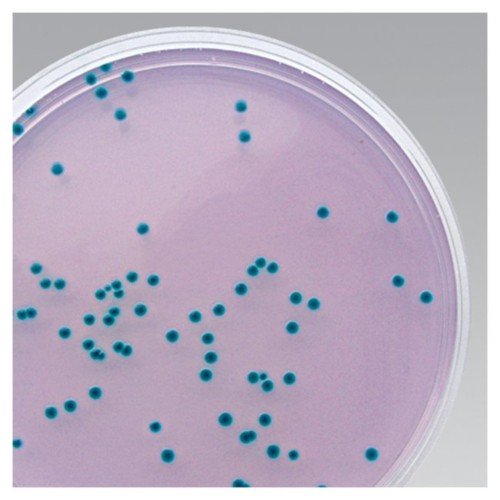
E.Sak Isolation Agar Base 500g
RM3,745.00Brand:
Thermo ScientificTM OxoidTM
Oxoid Cronobacter Sakazakii Isolation Agar (ISO) is a chromogenic medium for enrichment and isolation of Cronobacter spp. from milk and milk products in compliance with ISO/TS 22964: 2006.
E.Sak Isolation Agar Base, Oxoid Composition
| Typical Formula* | gm/litre |
| Pancreatic digest of casein† | 7.0 |
| Yeast extract | 3.0 |
| Sodium chloride | 5.0 |
| Sodium deoxycholate†† | 0.6 |
| 5-Bromo-4-chloro-3-indolyl α-D-glucopyranoside | 0.15 |
| Crystal violet | 0.002 |
| Agar | 12.0 |
| pH 7.0 ± 0.2 @ 25°C |
E.Sak Isolation Agar, Oxoid Preparation:
Suspend 27.75g in 1 litre of distilled water. Bring to the boil to dissolve completely. Sterilize by autoclaving at 121°C for 15 minutes. Cool to approximately 50°C. Mix well and pour into sterile Petri dishes.
Storage conditions and Shelf life
Store the dehydrated medium at 10-30°C and use before the expiry date on the label.
The prepared medium is best used freshly prepared, but may be suitable for longer storage following in-house validation.

E10 Erythromycin
RM0.00Brand:
Thermo ScientificTM OxoidTM

E15 Erythromycin
RM77.00Brand:
Thermo ScientificTM OxoidTM

E30 Erythromycin
RM0.00Brand:
Thermo ScientificTM OxoidTM

E5 Erythromycin
RM0.00Brand:
Thermo ScientificTM OxoidTM

EC Broth (Reduced Bile Salts) 500g
RM494.00Brand:
Thermo ScientificTM OxoidTM
- Oxoid EC Broth, Reduced Bile Salts is a selective enrichment broth for the growth of Escherichia coli O157 from food and environmental samples.
- Also available Novobiocin Selective Supplement, Part No. SR0181E.
EC Broth (Reduced Bile Salts), Oxoid Composition
| Typical Formula* | gm/litre |
| Tryptone | 20.0 |
| Lactose | 5.0 |
| Bile Salts No. 3 | 1.12 |
| Di-potassium phosphate | 4.0 |
| Mono-potassium phosphate | 1.5 |
| Sodium chloride | 5.0 |
| pH 6.9 ± 0.2 @ 25°C |
EC Broth (Reduced Bile Salts), Oxoid Preparation:
Dissolve 18.3g in 500ml of distilled water. Sterilise by autoclaving at 121°C for 15 minutes. Cool the EC Broth (Reduced Bile Salts) to 50°C and aseptically add the contents of 1 vial of Novobiocin Supplement SR0181, reconsituted as directed. Dispense into final sterile containers.
Storage conditions and Shelf life
Store the dehydrated medium at 10-30°C and use before the expiry date on the label.
When stored as directed, the supplement remains stable until the expiry date printed on the label.

Edwards Medium (Modified) 500g, Oxoid
RM1,398.00Brand:
Thermo ScientificTM OxoidTM
Oxoid Edwards Medium, Modified is used for selective isolation of Streptococcus agalactiae.
Edwards Medium, Modified, Oxoid Composition
| Typical Formula* | gm/litre |
| `Lab-Lemco’ powder | 10.0 |
| Peptone | 10.0 |
| Aesculin | 1.0 |
| Sodium chloride | 5.0 |
| Crystal violet | 0.0013 |
| Thallous sulphate | 0.33 |
| Agar | 15.0 |
| pH 7.4 ± 0.2 |
Edwards Medium, Modified, Oxoid Preparation:
Suspend 41g in 1 litre of distilled water. Bring to the boil to dissolve completely. Sterilise by autoclaving at 115°C for 20 minutes. Cool to 50°C, add 5-7% of sterile bovine or sheep blood, mix well and pour plates.
Storage conditions and Shelf life
Store the dehydrated medium at 10-30°C. and use before the expiry date on the label.
Store the prepared plates at 2-8°C.

Eft30 Ceftiofur
RM84.00Brand:
Thermo ScientificTM OxoidTM
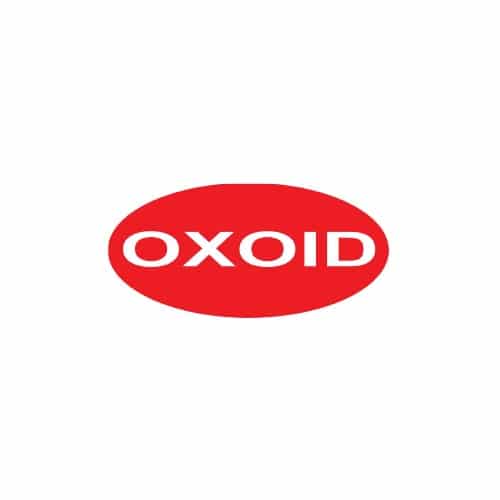
Egg Yolk Tellurite Emulsion
RM147.00Brand:
Thermo ScientificTM OxoidTM
Thermo Scientific™ Oxoid Egg Yolk Tellurite Emulsion is an emulsion of egg yolk containing potassium tellurite for use in Baird-Parker Medium CM0275 and Baird-Parker Medium (ISO) CM1127.

Endo Agar Base 500g
RM627.00Brand:
Thermo ScientificTM OxoidTM
A modified medium requiring the addition of basic fuchsin to form Endo Agar.
- Oxoid Endo Agar is an APHA recommended medium for the confirmation of coliforms.
- Also available Basic Fuchsin Indicator, Part No. BR0050A.
Endo Agar Base, Oxoid Composition
| Typical Formula* | gm/litre |
| Peptone | 10.0 |
| Lactose | 10.0 |
| Di-potassium phosphate | 3.5 |
| Sodium sulphite | 2.5 |
| Agar | 10.0 |
| pH 7.5 ± 0.2 @ 25°C |
Endo Agar, Oxoid Preparation:
Suspend 36g in 1 litre of distilled water. Add 6ml (or as directed by the supplier) of a 10% w/v solution of basic fuchsin BR0050 (50:50 ethanol/distilled water). Bring to the boil to dissolve completely. Sterilise by autoclaving at 121°C for 15 minutes. Mix well before pouring. Plates should be stored in the dark to preserve their pale pink colour.
BASIC FUCHSIN IS A POTENTIAL CARCINOGEN AND CARE SHOULD BE TAKEN TO AVOID INHALATION OF THE POWDERED DYE AND CONTAMINATION OF THE SKIN.
Storage conditions and Shelf life
Store the dehydrated medium at 10-30°C and use before the expiry date on the label.
Store the prepared plates at 2-8°C away from light.
Precautions
Weigh out the basic fuchsin (BR0050) in a fume cupboard and avoid inhalation of the powder or contamination of the skin.
Keep the prepared medium away from light to avoid photo-oxidation.
Endo Agar is quoted by the American Public Health Association as a `Standard Methods’ medium for use in water1 and dairy products. Windle Taylor recommended the medium for the isolation and differentiation of coli-aerogenes bacteria from water.

Enr5 Enrofloxacin
RM80.00Brand:
Thermo ScientificTM OxoidTM
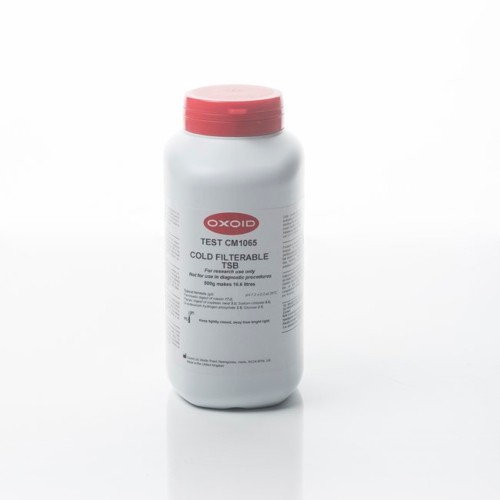
Enterobacteria Broth-Mossel (EP/USP/JP/BP) 500g
RM490.00Brand:
Thermo ScientificTM OxoidTM
Selectively enrich bile tolerant Gram-negative bacteria during microbiological examination of pharmaceutical products with Thermo Scientific™ Oxoid™ Enterobacteria Enrichment Broth-Mossel (EP/USP/JP/BP).
Enterobacteria Enrichment Broth-Mossel (EP/USP/JP/BP), Oxoid Composition
| Typical Formula | gm/litre |
| Pancreatic digest of gelatine | 10.0 |
| Glucose anhydrous | 4.5 |
| Bile Salts (Sodium desoxycholate, Sodium lauryl sulphate, Sodium citrate) | 3.055 |
| Potassium dihydrogen phosphate | 2.0 |
| Disodium hydrogen phosphate anhydrous | 6.4 |
| Brilliant green | 0.015 |
| pH 7.2 ± 0.2 @ 25°C |
Enterobacteria Enrichment Broth-Mossel (EP/USP/JP/BP), Oxoid Preparation:
Dissolve 25.97g in 1 litre of purified water. Mix well and distribute 100ml into 250ml flasks. Heat the medium at 100°C using free flowing steam for 30 minutes only. Cool rapidly in cold running water.
DO NOT AUTOCLAVE.
Storage conditions and Shelf life
Store the dehydrated medium at 10-30°C and use before the expiry date on the label.
Store the prepared medium at 2-25°C.

Eosin Methylene Blue Agar (Levine) 500g
RM356.00Brand:
Thermo ScientificTM OxoidTM
Detect, enumerate and differentiate the members of coliform group with Thermo Scientific™ Oxoid™ Eosin Methylene Blue Agar (Modified) Levine (Dehydrated). This versatile medium, modified by Levine is used for the differentiation of Escherichia coli and Enterobacteria aerogenes and also for rapid identification of Candida albicans. The medium is prepared to the formula specified by the APHA for the detection and differentiation of the coliform group of organisms.
Eosin Methylene Blue Agar (Modified) Levine, Oxoid Composition
| Typical Formula* | gm/litre |
| Peptone | 10.0 |
| Lactose | 10.0 |
| Dipotassium hydrogen phosphate | 2.0 |
| Eosin Y | 0.4 |
| Methylene blue | 0.065 |
| Agar | 15.0 |
| pH 6.8 ± 0.2 |
Eosin Methylene Blue Agar (Modified) Levine, Oxoid Preparation:
Suspend 37.5g in 1 litre of distilled water. Bring to the boil to dissolve completely. Sterilise by autoclaving at 121°C for 15 minutes. Cool to 60°C and shake the medium in order to oxidise the methylene blue (i.e. restore its blue colour) and to suspend the precipitate which is an essential part of the medium.
Storage conditions and Shelf life
Store the dehydrated medium at 10-30°C and use before the expiry date on the label.
Store the prepared plates at 2-8°C away from light.
Precautions
Further tests are required to confirm the presumptive identity of organisms isolated on this medium. Some strains of Salmonella and Shigella species will not grow in the presence of eosin and methylene blue. Store the medium away from light to prevent photo-oxidation.

Erythromycin 256 M.I.C.E. (10 Pack)
RM0.00Brand:
Thermo ScientificTM OxoidTM
**This product is not available at the moment.
Effortlessly establish accurate Minimum Inhibitory Concentration (MIC) values manually using Thermo Scientific™ Oxoid™ Erythromycin M.I.C.Evaluator Strips (M.I.C.E.™).

Erythromycin 256 M.I.C.E. (50 Pack)
RM0.00Brand:
Thermo ScientificTM OxoidTM
**This product is not available at the moment.
Effortlessly establish accurate Minimum Inhibitory Concentration (MIC) values manually using Thermo Scientific™ Oxoid™ Erythromycin M.I.C.Evaluator Strips (M.I.C.E.™).

Etp10 Ertapenem
RM80.00Brand:
Thermo ScientificTM OxoidTM



